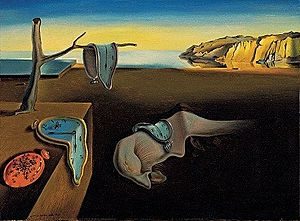
The contents of an image have changed after the invention of the camera. Camera movements and image availability alter the way we interpret the story and meaning of an image. The use of the camera today has made art like this easily accessible to the general public creating more possible meanings for a given image. The invention of the camera is used not just as a mechanism that manipulates the meaning of art externally but can be used internally as part of the image itself. Surrealism paintings often had a photographic likeness to them, which added a modernized feel. Surrealism was a 20th-century movement in art and literature that used irrational imagery to evoke the unconscious mind.
The Persistence of Memory is a 1931 surrealist painting by artist Salvador Dali. The four clocks look to be as they are melting while the white almost faded looking figure on the ground appears to be sleeping. The Persistence of Memory possibly represents the dream state. The clocks depict the passage of time in reality. The melting of the clocks and then ants on the clock furthest to the left represent times powerlessness in the dream state. Since time is something we deem very precious in the everyday world, the distortion of the clocks shown how irrelevant our conscious worries are to our unconscious mind.






